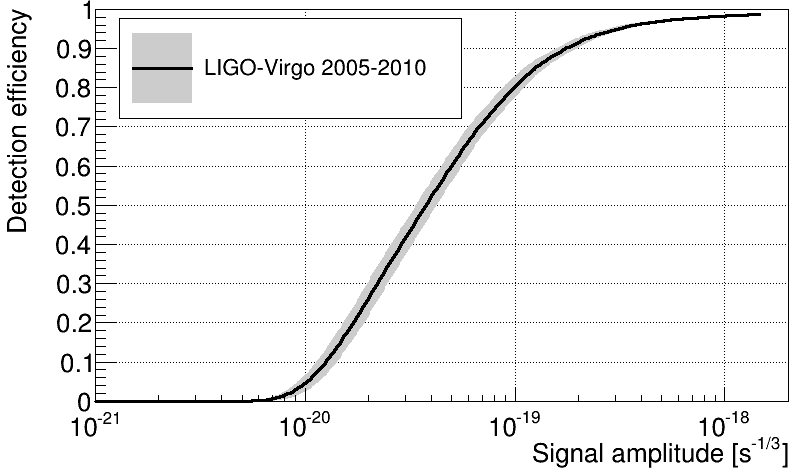Cosmic strings are objects that may have formed in the early Universe, but scientists are still searching for evidence that they exist. They were first introduced by theoretical physicist Tom W. B. Kibble in the late 70s as a possible result of some field theories, including the famous Higgs theory. They are one-dimensional (line-like) objects, similar to vortex lines in liquid helium , that could be left over after the early Universe went through a phase transition. Cosmic strings were a popular research topic in the 80s, since they could have triggered the formation of large-scale structures such as galaxies. However, the presence of cosmic strings in the early universe would leave an imprint in the cosmic microwave background [*] (CMB). Space-based experiments like COBE and WMAP revealed that cosmic strings do not make a measurable contribution to the CMB, thus ruling out a significant role for cosmic strings.
Cosmic strings were revisited in the early 2000s when it was realized that they could also form in the context of string theory. In a string theory, elementary particles are described by tiny one-dimensional objects in a multi-dimensional space. In some theories, the strings could grow to cosmological scales and behave like historical cosmic strings. These are called cosmic superstrings, and could provide precious observational signatures of string theory.
Assuming they do exist, the network of cosmic (super)strings formed in the early Universe would have evolved as the Universe expanded: strings stretched, interacted, oscillated, disintegrated… Massive computer simulations can describe this evolution from formation up to today, but they are challenging because many physical effects need to be taken into account. Some assumptions and simplifications are necessary to keep the simulation at a reasonable scale to be run by computers. An example of such a simulation is presented below.
Simulation of a cosmic string network. Long strings are represented in yellow and cosmic string loops are shown in red. © Cambridge cosmology group
There is currently no observational evidence of the existence of cosmic strings, and the CMB evidence proves they are not abundant. One of the most promising ways to detect these elusive objects is to search for the gravitational-wave radiation they would produce. Gravitational-wave emission is the main mechanism for cosmic strings to dissipate energy. When a string in a cosmic string network crosses itself, a loop separates from the string.

Cosmic string loop formation. A loop forms (a) when two strings interacts in 2 separate points or (b) when a string crosses itself. © Cambridge cosmology group
Once formed, a loop is doomed. It oscillates, radiates gravitationally, shrinks and eventually evaporates. Strong gravitational emission occurs at the pinch-off points of the loop, the cusps, which move with a velocity close to the speed of light. Powerful bursts of gravitational waves are expected to be produced by cosmic string cusps. The amplitude of the signal depends on the tension in the string and the size of the loop. These signals could be detected by the ground-based laser interferometers LIGO and Virgo. An example signal is presented below:

Predicted gravitational waveform [*] produced by a cosmic string cusp.
The chances of detecting a signal strongly depend on the sensitivity of the detectors and on our ability to distinguish a real signal from background noise in the detectors’ data. We have analyzed LIGO and Virgo data collected between 2005 and 2010, when detectors worked near or at design sensitivity. In addition, specific analysis methods (match-filtering, multivariate analysis) have been developed to optimize the extraction of a cusp signal buried in the noise of the detectors.

This plot shows the detection efficiency as a function of the cusp signal amplitude. It tells you the fraction of cosmic string cusp events of a given amplitude that our search should be able to find.
In spite of all our efforts, no evidence of a cosmic string signal has been found in LIGO/Virgo data. As often in experimental physics, a null result does not mean we didn’t learn anything. Knowing our search sensitivity, we can use the fact we did not detect anything to constrain the properties of cosmic strings. The constraints we obtained are the most stringent to date for some regions of the cosmic string parameter space. This new result places limits on physical models of cosmic strings and could be used to generate more accurate simulations of a string network.

This plot presents existing constraints on cosmic string parameters: the string tension Gµ, the loop size parameter ε and the probability p that two string segments interact when they meet. Our analysis is able to reject the regions filled in red. For comparison, other constraints derived from searches of a GW background from cosmic strings (pulsar / CMB / LIGO stochastic) are given fixing p at 1e-3.
In 2011 the LIGO and Virgo detectors stopped taking data and major detector upgrades are currently being installed. The advanced detectors should resume observation in 2015/16 with greater sensitivity than before. This offers a great opportunity for cosmic string searches since potential signals with much lower amplitudes should become visible. Advanced LIGO and Advanced Virgo should be able to provide a decisive input whether cosmic strings do or do not exist.

